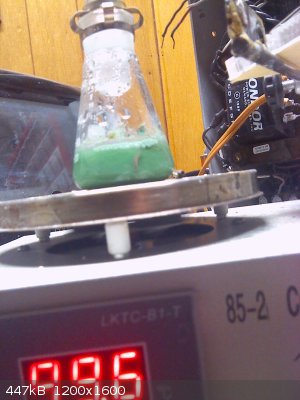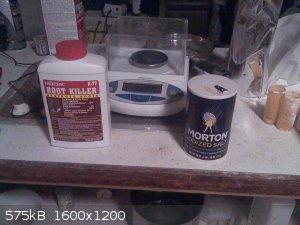idrbur
Hazard to Self
 
Posts: 88
Registered: 23-6-2015
Member Is Offline
Mood: No Mood
|
|
complication in making copper acetylide
I am trying to make copper acetylide from copper sulphate , naoh and acetylene .first i dissolve cuso4 in water and then add naoh to it then i
bubbled acetylene through it . It turned red-brown and a precipitate is formed but when i dried it turned black and its not copper acetylide .can
somebody tell me what's going wrong.
|
|
|
Tdep
National Hazard
   
Posts: 516
Registered: 31-1-2013
Location: Laser broken since Feb 2020 lol
Member Is Offline
Mood: PhD is done! It isn't good but it's over lol
|
|
Mate, mate, that's never going to work. Even the wikipedia page has fr more information than you seem to have. Firstly, you need a copper(I) salt..
not adding NaOH to... that'll just precipitate... ah i'm bored, just not bored enough to help you sorry. Everything's going wrong. Make Copper(I)
chloride to start with.
|
|
|
Kagutsuchi
Hazard to Self
 
Posts: 51
Registered: 21-6-2015
Location: Hungary
Member Is Offline
Mood: Happy
|
|
If you want to make copper acetylide, you should rather use coper(I) chloride, and ammonia instead of NaOH. You should make a concentrated solution of
the copper(I) salt, then add some ammonia (about 5% of the original solution by volume if it's 20 % ammonia) then bubble the acetylene through 
|
|
|
blogfast25
International Hazard
    
Posts: 10562
Registered: 3-2-2008
Location: Neverland
Member Is Offline
Mood: No Mood
|
|
Quote: Originally posted by Kagutsuchi  | You should make a concentrated solution of the copper(I) salt, then add some ammonia (about 5% of the original solution by volume if it's 20 %
ammonia) then bubble the acetylene through  |
There aren't many commercially available Cu(I) salts and most of those are insoluble/poorly soluble, see e.g. CuCl. But that dissolves easily in
strong ammonia solution.
You can prepare CuCl from CuSO4, copper wire and table salt by gently boiling all three together:
CuSO4(aq) + Cu(s) + 2 NaCl(aq) ===> 2 CuCl(s) + Na2SO4(aq)
CuCl precipitates as a white powder. Then dissolve in NH3 and filter. Lead acetylene through that solution and that should yield Cu(I) acetylide.
[Edited on 25-6-2015 by blogfast25]
|
|
|
kecskesajt
Hazard to Others
  
Posts: 299
Registered: 7-12-2014
Location: Hungary
Member Is Offline
Mood: No Mood
|
|
Also,dry and store in a cool,dry,light protected enviroment.After filtering,wash with 300ml of dest. water and then wash with diethyl ether.
|
|
|
Morgan
International Hazard
    
Posts: 1660
Registered: 28-12-2010
Member Is Offline
Mood: No Mood
|
|
I remember reading some account from long ago where a workman was blowing into a clogged copper pipe and it detonated killing the man. I couldn't find
it but there's this article.
https://books.google.com/books?id=zgcAAAAAMAAJ&pg=PA3&am...
So one day I took some 3 inch lengths of 1/2 inch diameter copper tubing and put them in a jar with some carbide lumps and a little ammonia if I
recall correctly and let that sit for several days. I was able to get some weak flashes of light from where the blackened surface of the copper had
reacted. I don't remember if it was from the friction of striking them against something or from a flame test. I may not have used any ammonia now
that I think about it but the copper tubing changed from a copper color to black. In the article about the copper tube explosion killing the man I
think they mentioned some trace gases in the acetylene that helped the reaction.
[Edited on 25-6-2015 by Morgan]
|
|
|
mayko
International Hazard
    
Posts: 1218
Registered: 17-1-2013
Location: Carrboro, NC
Member Is Offline
Mood: anomalous (Euclid class)
|
|
According to Brauer's Handbook of Preparative Inorganic Synthesis (available for download from the SciMad Library), the acetylene should be rigorously purified before reaction with the copper salt; they describe a series of gas washings. If
you're just interested in booms and bangs, though, a single wash with aqueous NaOH should be sufficient (this removes hydrogen sulfide impurities)
Curiously, Brauer *does* say that copper acetylide may be formed from copper sulfate and acetylene! This is briefly mentioned on p.26 during the
discussion of alcohol drying and purification. I wonder if acetylene is a sufficient to reduce Cu(II) to Cu(I) in solution? Alternatively, maybe this
reaction produces a *cupric* acetylide, CuC2, as opposed to the *cuprous* acetylide Cu2C2
[Edited on 25-6-2015 by mayko]
al-khemie is not a terrorist organization
"Chemicals, chemicals... I need chemicals!" - George Hayduke
"Wubbalubba dub-dub!" - Rick Sanchez
|
|
|
semiconductive
Hazard to Others
  
Posts: 287
Registered: 12-2-2017
Location: Scappoose Oregon, USA.
Member Is Offline
Mood: Explorative
|
|
Quote: Originally posted by blogfast25  |
You can prepare CuCl from CuSO4, copper wire and table salt by gently boiling all three together:
CuSO4(aq) + Cu(s) + 2 NaCl(aq) ===> 2 CuCl(s) + Na2SO4(aq)
CuCl precipitates as a white powder. Then dissolve in NH3 and filter. Lead acetylene through that solution and that should yield Cu(I) acetylide
|
I tried this last night, and it doesn't work.
I'm planning on attempting to make a copper acetlide from copper and MAPP gas, to see if hardware store MAPP gas will produce the same or similar
result to acetyline gas with a copper I chloride / ammonia mixture.
I tried your suggestion with CuSO4.5H2O, 2.522g (0.0101 mol), and 2*58.44g NaCl (0.0101 mol), and about a 2 grams of fine copper wire from the
hardware store; I put all three inside a 50ml Erlenmeyer flask with ground glass stopper and kek-clip to allow steam to escape but prevent air from
re-entering the flask.
The result was a slight amount of light green precipitate.
So, I then tried adding boiled de-ionized water and about 1mm of pure silicone oil (nearly inert) which floats on top. The result was a lighter green
precipitate, and any of the precipitate which managed to splash above the silicone oil due to boiling is light blue green.
No pure white precipitate was produced under any condition.
From the sciencemadness wiki's, and wikipedia articles, I learned that table salt (NaCl) has the property of converting CuCl into a copper
oxy-chloride aka dicopper chloride tri-hydroxide, (AKA basic copper chloride): Cu2(OH)3Cl.
http://www.sciencemadness.org/smwiki/index.php/Copper_oxychl...
https://en.wikipedia.org/wiki/Dicopper_chloride_trihydroxide
The articles imply that the presence of atmospheric oxygen enters water and causes the conversion. Note carefully: The Wikipedia article says a brine
process is used to efficiently convert CuCl into Cu2(OH)3Cl; eg: salt water + heat (60-90C).
Even though I later attempted to seal the Erlenmeyer flask, and I used silicone oil to reduce oxygen penetration by floating 1mm of it on the
reagents' surface; I still ended up with the light green precipitate. Apparently, either a contaminant from househould salt and copper sulfate,
contains oxygen or else a contaminant can break down water to provide the oxygen needed for conversion under brine.
So your suggestion appears to make the oxychloride, and not copper I chloride from common household chemicals under any reasonable attempt to do the
reaction an-oxically.
I am thinking to retry the experiment at 50C, but in my first trial (already described) I pre-warmed the solution to 40C -- and the copper wire was
already coated with a film of crystals hindering chemical reactions; The copper did not become clean until the heat rose somewhere above 75C, so I am
not hopeful that your method of synthesis will work at all. The first reaction already took almost two days to get all the copper II chloride in
solution to react with copper metal even at 90 to 99C; even now it has a slight color to the remaining water. So if I retry again at 50C, I expect
the reaction to be impractically slow.


[Edited on 23-11-2017 by semiconductive]
|
|
|